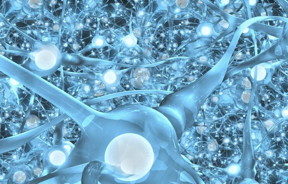Home > Press > Research showing why hierarchy exists will aid the development of artificial intelligence
 |
| New research explains why so many biological networks, including the human brain (a network of neurons), exhibit a hierarchical structure, and will improve attempts to create artificial intelligence. The study, published in PLOS Computational Biology, demonstrates this by showing that the evolution of hierarchy -- a simple system of ranking -- in biological networks may arise because of the costs associated with network connections. CREDIT: Steven T. Caputo, CereberalHack.com |
Abstract:
New research explains why so many biological networks, including the human brain (a network of neurons), exhibit a hierarchical structure, and will improve attempts to create artificial intelligence. The study, published in PLOS Computational Biology, demonstrates this by showing that the evolution of hierarchy - a simple system of ranking - in biological networks may arise because of the costs associated with network connections.
Research showing why hierarchy exists will aid the development of artificial intelligence
San Francisco, CA | Posted on June 13th, 2016Like large businesses, many biological networks are hierarchically organised, such as gene, protein, neural, and metabolic networks. This means they have separate units that can each be repeatedly divided into smaller and smaller subunits. For example, the human brain has separate areas for motor control and tactile processing, and each of these areas consist of sub-regions that govern different parts of the body.
But why do so many biological networks evolve to be hierarchical? The results of this paper suggest that hierarchy evolves not because it produces more efficient networks, but instead because hierarchically wired networks have fewer connections. This is because connections in biological networks are expensive - they have to be built, housed, maintained, etc. - and there is therefore an evolutionary pressure to reduce the number of connections.
In addition to shedding light on the emergence of hierarchy across the many domains in which it appears, these findings may also accelerate future research into evolving more complex, intelligent computational brains in the fields of artificial intelligence and robotics.
Researchers from the University of Wyoming and INRIA (France) led by Henok S. Mengistu simulated the evolution of computational brain models, known as artificial neural networks, both with and without a cost for network connections. They found that hierarchical structures emerge much more frequently when a cost for connections is present.
Author Jeff Clune says, "For over a decade we have been on a quest to understand why networks evolve to have the properties of modularity, hierarchy, and regularity. With these results, we have now uncovered evolutionary drivers for each of these key properties." Mengistu notes: "The findings not only explain why biological networks are hierarchical, they might also give an explanation for why many man-made systems such as the Internet and road systems are also hierarchical."
Author Joost Huizinga adds "The next step is to harness and combine this knowledge to evolve large-scale, structurally organized networks in the hopes of creating better artificial intelligence and increasing our understanding of the evolution of animal intelligence, including our own."
####
For more information, please click here
Contacts:
Jeff Clune
Copyright © PLOS
If you have a comment, please Contact us.Issuers of news releases, not 7th Wave, Inc. or Nanotechnology Now, are solely responsible for the accuracy of the content.
| Related News Press |
News and information
![]() Researchers develop molecular qubits that communicate at telecom frequencies October 3rd, 2025
Researchers develop molecular qubits that communicate at telecom frequencies October 3rd, 2025
![]() Next-generation quantum communication October 3rd, 2025
Next-generation quantum communication October 3rd, 2025
![]() "Nanoreactor" cage uses visible light for catalytic and ultra-selective cross-cycloadditions October 3rd, 2025
"Nanoreactor" cage uses visible light for catalytic and ultra-selective cross-cycloadditions October 3rd, 2025
Possible Futures
![]() Spinel-type sulfide semiconductors to operate the next-generation LEDs and solar cells For solar-cell absorbers and green-LED source October 3rd, 2025
Spinel-type sulfide semiconductors to operate the next-generation LEDs and solar cells For solar-cell absorbers and green-LED source October 3rd, 2025
Interviews/Book Reviews/Essays/Reports/Podcasts/Journals/White papers/Posters
![]() Spinel-type sulfide semiconductors to operate the next-generation LEDs and solar cells For solar-cell absorbers and green-LED source October 3rd, 2025
Spinel-type sulfide semiconductors to operate the next-generation LEDs and solar cells For solar-cell absorbers and green-LED source October 3rd, 2025
![]() Rice membrane extracts lithium from brines with greater speed, less waste October 3rd, 2025
Rice membrane extracts lithium from brines with greater speed, less waste October 3rd, 2025
Artificial Intelligence
![]() New quantum encoding methods slash circuit complexity in machine learning November 8th, 2024
New quantum encoding methods slash circuit complexity in machine learning November 8th, 2024
![]() Rice research could make weird AI images a thing of the past: New diffusion model approach solves the aspect ratio problem September 13th, 2024
Rice research could make weird AI images a thing of the past: New diffusion model approach solves the aspect ratio problem September 13th, 2024
![]() Simulating magnetization in a Heisenberg quantum spin chain April 5th, 2024
Simulating magnetization in a Heisenberg quantum spin chain April 5th, 2024
Alliances/Trade associations/Partnerships/Distributorships
![]() Chicago Quantum Exchange welcomes six new partners highlighting quantum technology solutions, from Chicago and beyond September 23rd, 2022
Chicago Quantum Exchange welcomes six new partners highlighting quantum technology solutions, from Chicago and beyond September 23rd, 2022
![]() University of Illinois Chicago joins Brookhaven Lab's Quantum Center June 10th, 2022
University of Illinois Chicago joins Brookhaven Lab's Quantum Center June 10th, 2022
|
|
||
|
|
||
| The latest news from around the world, FREE | ||
|
|
||
|
|
||
| Premium Products | ||
|
|
||
|
Only the news you want to read!
Learn More |
||
|
|
||
|
Full-service, expert consulting
Learn More |
||
|
|
||








